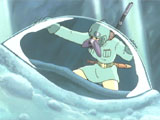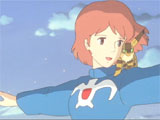

Quick Links:
Nausicaä of the Valley of Wind (Kaze no Tani no Naushika)
Nausicaä of the Valley of Wind is a brilliant and moving epic from the mind of Mr. Hayao Miyazaki. The story began as a serial manga in 1982, appearing in the magazine Animage. It would be 1994 before the manga was completed, but Miyazaki and his Studio Ghibli made the story of Nausicaä into their first film and released it in 1984. Perhaps, in some ways, the story should not have been made into film. In other ways, it is the film that created Studio Ghibli's identity and changed the animation world forever.
Nausicaä is set in a sort of future middle age, where a toxic forest full of fungi and giant insects covers most of the world. (Humans must wear a protective mask when entering the forest, so as to avoid its toxins.) Legend says this "Sea of Corruption" was brought forth after an event called the "Seven Days of Fire" destroyed most of the civilized society a thousand years ago. Among the giant insects are the Ohmu - hard-shelled creatures that protect the forest from humans' destructive power.
The story begins with a young princess named Nausicaä discovering the shell of an Ohmu in the forest. She takes a piece of the shell and begins to return to her village (in the Valley of Wind), when she spots an Ohmu chasing a person out of the forest. She calms the Ohmu and leads it back to the forest, then discovers that the man she saved is a man named Yupa, whom she looked up to in her childhood and still does. He brings stories of more and more towns being consumed by the Sea of Corruption, and the film is primarily about the Valley of Wind's struggle to avoid the same fate. Other characters of interest that appear in the film are: Lastel and Asbel from the country of Pejite, a nation who discovered one of the massively destructive weapons of ancient times; and Kushana and Kurotawa from Torumeka, a country that seeks to burn away the Sea of Corruption. The graphic novels incorporate quite a few other major characters, and most of them portray a particular flaw of humanity.
The brilliance of Nausicaä is it states the obvious in a subtle manner. Haste leads to foolish deeds. Violence does not produce any sort of resolution. And perhaps most importantly: man can only hurt himself by interfering with nature. The main irony that drives the story is in the Sea of Corruption itself. The destructive nature of humans brought it about and continues to sustain it, yet the toxic forest is anything but corrupt. Only Nausicaä herself, with her "live and let live" mindset, seems to understand why humanity has been made to suffer, and she is the vehicle for positive change in the story.
The character of Nausicaä is a showcase of humanity's virtues. She listens, and is openly loving of everyone and everything. She is alert and receptive to change. She is faithful, and a visionary. Everyone and every thing is taken by her, from the cold and rigid Kushana to even the Ohmu and the insects of the forest. Her importance in the story isn't the incredible things she does, so much as who she is and what she represents.
But you probably wouldn't get a feel for all that just by watching the movie, and therein lies the problem. Epics have a tendency to not fit in a few hundred pages, let alone a 2-hour movie. Needless to say, the film doesn't have the freedom to expand on most of the story's insights, nor does it have the time to reflect on important events and approach a resolution.
What it does have is some gripping and memorable music from Mr. Joe Hisaishi. The music helps to keep the film moving along despite the patchwork story. Aside from that, it's admittedly great to see Nausicaa in action on her strange glider machine. Nausicaä has the same quality of animation and vibrant colors that people have gotten used to expecting from a Ghibli movie.
While Nausicaä has few merits as a standalone work (the chief merit being the music), it does serve as an excellent introduction to the world and characters of the graphic novels. The manga and film do complement each other rather well, despite the fact that the story took a different path in the graphic novels, after the film was made. A good order for experiencing Nausicaä is film first, graphic novels second. And if you like the film, I wholly recommend experiencing the graphic novels. They're really something.
Distributor: Disney Creator: Hayao Miyazaki / Studio Ghibli Released: 1984
Plot: B- Character Design: B+ Animation Quality: A Music: A Overall: B+



